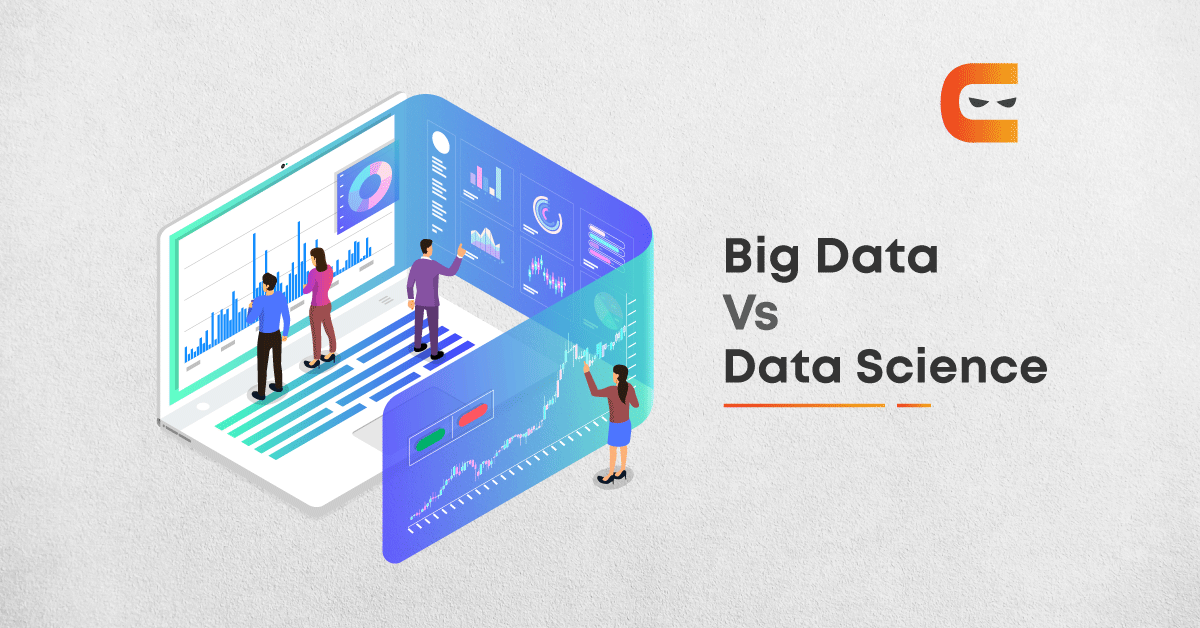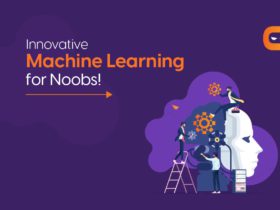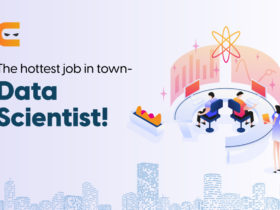Table of Contents
Introduction
Often Big Data is mistaken for Data Science by data analysts and data scientists aspirants and vice-versa, the two terms are distinct and have an extensively broad meaning. Although, the field of Big Data is analogous to that of Data Science, yet there is a wide chain of differences between the two.
First, let’s understand the meaning of the two terms and their implications individually, then we shall discuss their differences on various bases to get more clarity on Big Data vs Data Science.
What is Big Data?
Big data manages and manipulates extended collections of non-uniform data coming from different sources and not available in the standard database formats that we are familiar with. This implies that such data won’t be logically arranged into a table or chart or graph. Data management is a set of disciplines and techniques used to process, store and organize data.
Big data classifies data as unstructured, semi-structured, and structured data.
- Unstructured data – social networking media, emails, blogs, digital images, and web content.
- Semi-structured data – XML files, text files, etc.
- Structured data – RDBMS, OLTP, Data Structures such as an array, linked list and queue and other structured formats.
The image shows the application of Big Data in Healthcare
Image Source: allerin.com
There are five V’s of Big Data
1. Volume:
- The name ‘Big Data’ itself is related to a size that is huge.
- For determining the value of data, its value plays a very crucial role. If the volume of data is very high then it is actually considered as ‘Big Data’.
2. Velocity:
- Velocity refers to the high speed of collection of data.
- There is a massive and continuous flow of data in the industry these days.
3. Variety:
- It refers to the nature of data that is structured, semi-structured and unstructured data.
- It also implies that the data is coming from non-uniform sources.
4. Veracity:
- It refers to the uncertainty in data, that is data that is available can sometimes be inaccurate or complex.
- Example: Unconfirmed biological data, social media data.
5. Value:
- After having the 4 V’s into account there comes one more V which stands for Value!
- The bulk of Data with no Value is good for nothing for the company unless it is turned into something useful.
On one hand, structured data is really easy to understand, whereas unstructured data needs customised modelling techniques to extract information from the data. This is achieved with the assistance of relevant computer tools, statistics, and other data science approaches.
Pros of Big Data
- It provides real-time forecasting and monitoring of business decisions and market fluctuations.
- Seeks for the delicate turns present within a large dataset to influence business decisions.
- Efficiently eliminates risks by optimising complex decisions for future events and potential threats.
- Identify errors in systems and supply chain management in real-time.
- Provides insights by studying dynamics of data-driven marketing.
- Study customer data for providing tailor-made products, services, offers, discounts, etc.
- Allows swift delivery of products/services that meet the client’s expectations.
- Modify revenue streams to increase profits and ROI.
- Instant and automated response to customer requests, grievances, and queries.
- Introduces innovation in business strategies, products, and services.
What is Data Science?
Data Science refers to the complicated study of the massive amounts of data stored in a company’s or organisation’s repository. It includes tracking the origin of the data, the exact study of its content, and using it to accelerate the growth of the firm.
Data Science includes the entire process of data extraction, data visualisation, data cleansing and data analysis. The data stored in an organisation’s repository can be grouped into two categories – Structured and Unstructured.
After analysing these data sets, data scientists interpret some information that can be used to derive market trends, this helps the business in generalising the consumer’s activity and noting their response towards the various price fluctuations and product changes for future references.
Data scientists are experts who put raw data into use for handling crucial business matters. Data Scientists have thorough knowledge about coding paradigms, numerical computation, statistics, graphical representation of data for carrying out data visualisation and extraction.
Image Source: Intellipaat
The applications of Data Science have tremendously increased over the last few years, it is widely being used by companies such as Amazon and Netflix for generating recommendations for users. Data Science is also widely used in the fraud detection sector, search engines, airline and banking software, healthcare sector and so on.
Pros of Data Science
- Comes with numerous career opportunities
- Develop essential qualities for a revolutionary future
- Weightage to technical and practical abilities
- Gain intriguing And fascinating knowledge
- Create and develop unique And innovative projects
- Empowering management and officers to make better decisions
- Directing actions based on the latest market trends, which in turn assists in defining goals
- Challenging the staff to adopt the best practices and focus on issues that are really important
- Accurate decision making with quantifiable and data-driven evidence
Big Data vs Data Science: A head-to-head comparison
Being a data science aspirant, you must distinctly understand the difference between the two widely used data terms: “Big Data” vs “Data Science”. After reading the above-mentioned introduction, you must now go through the head-to-head comparison between the two through the difference table given below.
Big Data vs Data Science: Difference Table
| Basis | Big Data | Data Science |
| Meaning | Focuses on the large volumes of data which cannot be handled using the traditional data analysis method. | Refers to the complicated study of the massive amounts of data stored in a company’s or organisation’s repository. |
| Concept | Scientific techniques to process data, extract information and, thereof interpret the results which assists in the decision-making process. | Sometimes the big data is obtained is heterogeneous, this indicates a diversified data set which has to be pre-cleaned and sorted before running analytics on them |
| Origin | Data filtering, data preparation, and data analysis. | Internet users/ traffic, live feeds, and data retrieved from system logs. |
| Areas of Application | Telecommunication, social media, finance service, health and sports, research and development, and security and law enforcement. | Improving search results, digital advertisements, natural language processing, text-to-speech recognition, risk detection, and other activities. |
| Approach | Used by businesses to track their presence in the market which helps them develop agility and gain a competitive advantage over others | Uses mathematics and statistics extensively along with programming skills to develop a model to test the hypothesis and make decisions in the business |
| Tools used | Hadoop, Spark, Flink | SAS, R programming, Python |
Frequently Asked Questions
Data Science is better for those who are familiar with extensive R programming as it is used for executing analytics projects, whereas Big Data is recommended for Hadoop experts. You can pick one or both based on your interests and requirements.
The key differences between data science and big data analytics:
1. Data analytics focuses more on displaying the historical data in any context while data science is directed more towards machine learning and predictive analysis.
2. Data science is a multi-disciplinary domain that focuses largely on algorithm development, data inference, and predictive modeling to solve analytically complex business problems. While data analytics involves several other distinct branches of broader statistics and analysis.
The key difference between big data and data is that big data is unstructured whereas data is structured.
Data:
1. It refers to “Structured” data.
2. The volume of data is quite less.
3. The data is centralised in a local database.
4. It can be easily manipulated.
5. It can be configured by the normal system.
6. Traditional database management systems such as SQL are sufficient.
7. Data can be manipulated by simple functions.
Big Data:
1. It refers to “Unstructured” data.
2. Big data has an enormous volume.
3. The data is distributed over the cloud.
4. It cannot be easily manipulated.
5. For processing big data high system configuration is required.
6. Modern data management tools such as R and Hadoop are required.
7. Complex statistical functions are required for data manipulation.
Data science works on big data to derive useful insights by running a predictive analysis where results are used for making smart decisions. Therefore, we can consider Big Data to be the raw material for Data Science.
Spark, Storm, and DataTorrent RTS are considered to be the three solid real-time Big Data alternatives.
The term “big data” refers to data that is so large, fast, or complex that it is quite difficult or impossible to process it with the help of conventional data manipulation methods. The act of accessing and storing large amounts of information for analytics has been there, but Big Data added value to it with the help of the V’s.
Key Takeaways
Finally, after understanding both these terms we can conclude that both Big Data and Data Science go hand in hand. Big Data and Data Science are mostly used together, such as Big Data process the data which is present in HDFS, Data Science’s file system. However, both of them are unique and separate entities, each comes with its own pros and cons and specific business use cases.
If you are thinking of building a career in Data Analysis or Data Science with Big Data or Data Science you can learn about a few software including R, Python, SQL, this will help you in dealing with data sets better and devising the algorithms efficiently.
Before getting enrolled in any course understand the technical terms distinctly, so that you get to learn exactly what you have been looking for. You can check out our courses on Data Science and Machine Learning if you wish to build a few projects on your own under the guidance of our Mentors.
By Vanshika Singolia















Leave a Reply